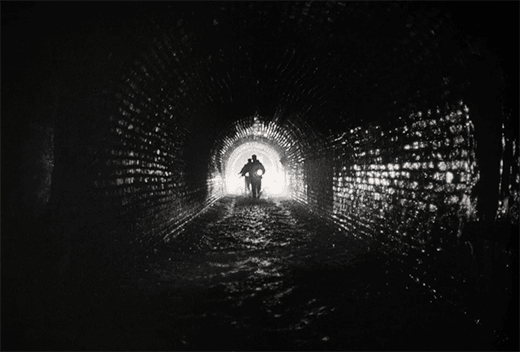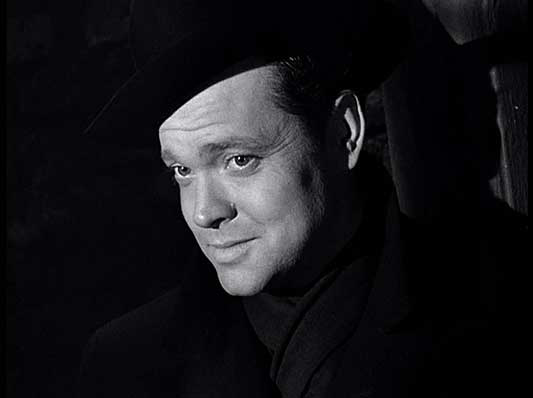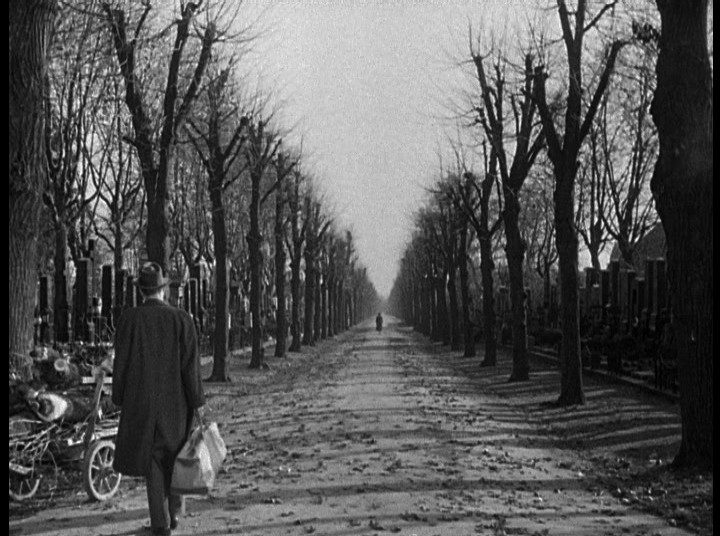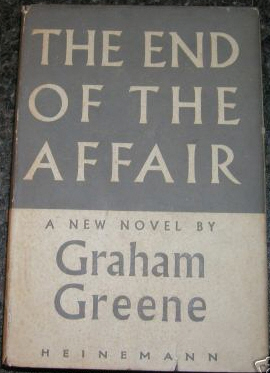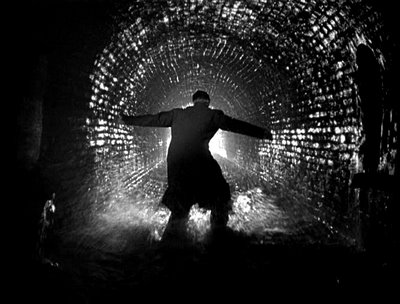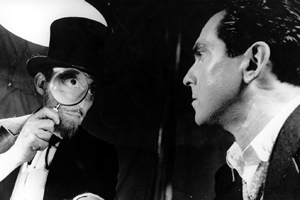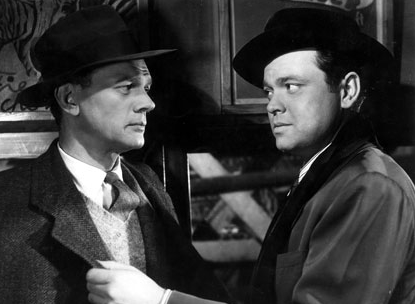From the July 30, 1999 issue of the Chicago Reader. This is also reprinted in my book Discovering Orson Welles. In retrospect, I clearly should have given this movie four stars. — J.R.
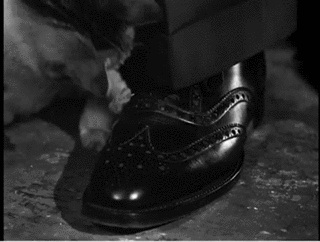
The Third Man
Rating *** A must see
Directed by Carol Reed
Written by Graham Greene
With Joseph Cotten, Alida Valli, Orson Welles, Trevor Howard, Bernard Lee, Wilfrid Hyde-White, Ernst Deutsch, Siegfried Breuer, and Erich Ponto.
Ironically, the most successful and beloved movie Orson Welles was ever associated with — and the one that may have had the most significant effect on the remainder of his career — has not been one of his own. Admittedly, Citizen Kane has more prestige, but that’s a relatively recent development; for the first quarter of a century after it was made, it was criticized as “uncinematic” in the few standard works of film history available, such as The Liveliest Art and The Film Till Now. Instead it was The Third Man (1950) that was most often cited with pleasure when Welles’s name came up. “Didn’t he direct that?” was something I used to hear a lot. Today I hear “Didn’t he direct at least some of the scenes?”
From the testimony of everyone involved, including Welles, we know that he wrote one brief and highly memorable speech comparing Italy and Switzerland (which he once claimed he cribbed from an old Hungarian play) and rewrote a couple of his other lines in the same scene. But he didn’t direct anything in the picture; the basics of his shooting and editing style, its music and meaning, are plainly absent. Yet old myths die hard, and some viewers persist in believing otherwise. Sometimes they also want to believe that he secretly directed portions of at least half of the other pictures he acted in. Similarly, some viewers persist in regarding this British movie set in postwar Vienna as American; it was even ranked 57th in the American Film Institute’s “100 greatest American movies” poll last year, though I’ve never known anyone outside the United States who harbored this colonialist fantasy.
Presumably people can sustain this fantasy because two of the three most important characters — the highly visible Holly Martins (Joseph Cotten) and the mainly invisible Harry Lime (Welles) — are American. Moreover, David O. Selznick, who also was American, plastered his name all over the movie, trimmed several shots and sequences for the American market, and even replaced producer-director Carol Reed’s expository offscreen narration at the beginning with a slightly different narration delivered by Cotten. The original and better version released in Europe — what might be termed the Alexander Korda version — has recently been restored and is playing this week at the Music Box. This version, which has been available only in some video editions, has longer stretches during which the Austrian characters speak in German without subtitles as well as better pacing throughout.
Korda, the Hungarian-born British producer, played a much more active and creative role on the film than Selznick. He’d also developed many previous film projects for Welles to direct, though none of them ever came to fruition (including Around the World in 80 Days, Cyrano de Bergerac, War and Peace, an American version of Pirandello’s Henry IV, and two original scripts, V.I.P. and Operation Cinderella). But not even Korda qualifies as the movie’s principal auteur. In fact, it’s doubtful that the movie can be read in auteurist terms at all. Like Gilda and Children of Paradise, it’s an anomaly whose special qualities come from a series of creative convergences rather than from a single dominant artistic sensibility — another reason people might fantasize that Welles directed parts of it.
The Third Man is wonderful entertainment, as it was designed to be, and there are certainly moments in it that deserve to be called artful as well as stylish; foremost among these are the first appearance of Welles, carefully plotted by Reed, and the final shot, which is 35 seconds longer in the Korda version and was conceived by Reed over the objections of Graham Greene, who scripted a more conventional happy and romantic ending (though he later admitted Reed was right). But even these virtues don’t give it the art or style of Welles’s own pictures; it has only superficial aspects of his art and style.
I’m also reluctant to call it anybody’s masterpiece, because its virtues are so closely allied with its limitations. “Masterpiece” implies “master,” and however accomplished Reed and Greene are in their roles, they arguably did a better job on the lesser-known The Fallen Idol, a 1948 picture based on Greene’s story “The Basement Room.” To my taste, Reed’s hokey but powerful Odd Man Out (1946), scripted by F.L. Green and R.C. Sherriff, and Greene’s 1951 novel The End of the Affair are more deserving of the term masterpiece.
Perhaps the best account of the limitations of The Third Man can be found in Manny Farber’s mixed review: “The movie’s verve comes from the abstract use of a jangling zither and from squirting Orson Welles into the plot piecemeal with a tricky, facetious eyedropper. The charm, documentary skill, and playful cunning that fashioned this character make his Morse-code appearances almost as exciting visually as each new make-believe by Rembrandt in his self-portraits…. Reed’s nervous, hesitant film is actually held together by the wires of its exhilarating zither, which sounds like a trio and hits one’s consciousness like a cloudburst of sewing needles. Raining aggressive notes around the characters, it chastises them for being so inactive and fragmentary and gives the film the unity and movement the story lacks.” Farber also faulted Greene for his snobbish handling of Cotten’s character, more specifically his profession as a pulp writer, which Greene used largely for cheap laughs. (An alcoholic in love with Lime’s former yet still loyal girlfriend Anna, Martins is depicted mainly as a weak character whose sense of decency, at least in contrast to Lime’s, is partially and ironically perceived as a sign of weakness.)
Reed and Korda insisted on casting Welles as Lime — an American black marketer who sells diluted penicillin to Vienna hospitals — over Selznick’s objections. Selznick became important only in the casting of Cotten (as Lime’s best friend, summoned by Lime from the States) and Alida Valli (as Anna, a Czech refugee posing as an Austrian, betrayed by Lime to the Russians), both of whom he held under contract. Greene’s original story was about the friendship between two Englishmen, but once they became two Americans, the picture began to echo the Wellesian theme of betrayed male friendship and certain related ideas from Citizen Kane — e.g., Cotten playing a writer and Welles playing a charming rogue of dubious morals who hires him.
To this Reed added the Wellesian visual motifs of shadows and tilted angles, though they don’t function as dramatic and metaphysical markers but simply conjure up a mood and atmosphere: shadows equal mystery and skulduggery, tilted angles mean everything’s slightly off-kilter. It’s a loose strategy for depicting the rubble-strewn Vienna of that period, which had been sliced into American, British, Russian, and French zones with an international zone for the police at the center. Another strategy was hosing down the cobblestone streets and shooting most of the film at night to allow Robert Krasker’s high-contrast cinematography to capitalize on all the murky ambience, and Greene’s own background as a spy undoubtedly enhanced the sense of intrigue. Yet for all the art of Greene’s storytelling, it wasn’t until Reed added the solo zither music of Anton Karas — most of it recorded in Reed’s house in London — that the picture acquired the “unity and movement” cited by Farber. This is why I find it easier to speak about artfulness and stylishness in this movie than about art and style; its pleasures are less those of a unified expression than those of several independent discourses merging in superficial harmony.
If the collective makers of The Third Man had a single precursor, it would have been Joseph Conrad, whose work considerably influenced both Welles and Greene. Welles’s first film project, preceding Kane, was a contemporary adaptation of Conrad’s “Heart of Darkness,” a story built around the much-delayed appearance of its evil and ruthless but charismatic villain, Kurtz. And, as James Naremore points out in his recent book on film noir, there’s a character named Kurtz in The Third Man. Greene’s The Heart of the Matter, which preceded The Third Man by a year or so, was influenced in other ways by the same story. (Later in his career, Welles wrote unrealized scripts based on Conrad’s Lord Jim and Victory and Greene’s Conradian The Honorary Consul.)
The Third Man would have been inconceivable without “Heart of Darkness,” and when Welles the actor stepped into his villainous part, a character analogous to Conrad’s Kurtz — the unscrupulous exploiter from abroad, putting in his first, brief appearance an hour into the film — he knew from his theater experience as well as from his first screenplay that less from an actor could add up to more in terms of public perception. He’d discovered that a great performance could dominate an entire film even if it consisted of only one terrific scene, one moment of standing hidden in a doorway, and a few stray shots of fleeing through the streets and sewers. As he put it to Peter Bogdanovich, “The old star actors never liked to come on until the end of the first act. Mr. Wu is a classic example — I’ve played it once myself. All the other actors boil around the stage for about an hour shrieking, ‘What will happen when Mr. Wu arrives?’ ‘What is he like, this Mr. Wu?’ and so on. Finally a great gong is beaten, and slowly over a Chinese bridge comes Mr. Wu himself in full mandarin robes. Peach Blossom (or whatever her name is) falls on her face and a lot of coolies yell, ‘Mr. Wu!!!’ The curtain comes down, the audience goes wild, and everyone says, ‘Isn’t that guy playing Mr. Wu a great actor!’ That’s a star part for you! What matters in that kind of role is not how many lines you have, but how few. What counts is how much the other characters talk about you. Such a star vehicle really is a vehicle. All you have to do is ride.”
In these terms, Harry Lime became Welles’s express train. For the first hour of The Third Man virtually nothing is discussed except Lime. When he finally turns up, he’s played by Welles without any makeup or false hair (apparently for the only time in his career), giving the film a special and legendary status in his work as a whole. Yet his physical participation in the film was so brief and limited that assistant director Guy Hamilton served as his double for many of the shots in the sewer, and Reed’s fingers were used when Lime’s hands emerge from a sewer grate. At that point Welles had left Vienna and was off hustling money to complete his film version of Othello; he had to settle for a flat acting fee for The Third Man rather than a percentage of the gross, which he much regretted later.
Although it wasn’t his film, it was often remembered as his; consequently Harry Lime became part of his meal ticket — not so much his signature as his designated alias, which, metaphorically speaking, was useful when it came to cashing checks. In early 1951 he began playing Lime in a half-hour radio show recorded in London and occasionally Paris that had at least 39 episodes; at least a dozen were scripted by Welles, and a few may have been unofficially directed by him as well. This was by far the most extensive radio gig he’d had after abandoning American radio in the late 40s, and the series got some exposure in the U.S. when it was syndicated as The Third Man: The Lives of Harry Lime, though it’s seldom spoken of today. Many of these shows have recently been revived on German radio; listening this past spring to several of them, I was struck by how consistently they traffic in the same world-weary depiction of postwar European dissolution projected by The Third Man, despite the wit and high spirits of the lead character. The Lime in these shows is more a hero than a villain — still a rogue but no longer evil (a quality typically reserved for scheming female characters and a few male crooks) — and the political bent of the shows is liberal, though less anti-American than most of Greene’s work during the same period. In his little-known, progressive 1956 European TV series Around the World With Orson Welles, the third of six completed episodes was called “The Third Man in Vienna,” and in the late 60s, when he was working on Orson’s Bag, a never-completed TV special for CBS (currently being restored by the Munich Film Archives), he included a segment called “Spying in Vienna” that harks back directly to The Third Man. And not long before his death, in what may have been the best of his late scripts, “The Big Brass Ring,” he placed his own character, Menaker, on a Ferris wheel, just like Harry Lime in his best scene — though in this case the character’s voyeuristic distance from others (a couple making love in a nearby flat) expressed pathos rather than chilling misanthropy (Lime’s speech to Martins about the “dots” below). I’m told George Hickenlooper deleted this scene when he directed a substantially revised version of the script — a film scheduled to turn up on Showtime next month — which may be just as well considering how beautifully it’s realized in the script.
Out of several of Welles’s radio scripts for The Adventures of Harry Lime grew his screenplay for Mr. Arkadin (1955), with its own black-marketeering protagonist, set in a similar world of postwar European corruption and crime. (As if to acknowledge its source, Arkadin literally restages one shot from The Third Man — a giant close-up of an eye behind a magnifying glass.) But here the Lime role is taken over by the completely uncharismatic Guy Van Stratten (Robert Arden), while Welles plays a Russian tycoon of mysterious origins.
I’m reminded of the process by which one of Welles’s precursors, the great Erich von Stroheim, revised some of his own priorities early in his career. When his first feature, which he called The Pinnacle, was retitled Blind Husbands without his consent or permission, he took out a full-page ad in a trade paper denouncing the head of Universal Pictures, Carl Laemmle, for the change. But after Blind Husbands cleaned up at the box office, he was quite happy to call his third feature, a spin-off of Blind Husbands, Foolish Wives; there’s even some possibility that he briefly considered calling his adaptation of McTeague, by Frank Norris, Greedy Wives instead of Greed.
Welles — who hated the Harry Lime character too much to have been able to make him palatable in a movie of his own — was turned by Korda, Greene, and Reed into such a charming monster that most moviegoers have preferred to remember him that way: Welles without his customary self-critique, playing the guiltless profiteer. Moreover, because this is one of Greene’s “entertainments,” we’re not shown any of the children in the Vienna hospital who’ve been treated with Lime’s diluted penicillin — unlike Martins, who’s taken there by a British officer (Trevor Howard) who correctly surmises that seeing the children will goad him into betraying his best friend. In other words, watered-down penicillin was actually sold on the Vienna black market during this period, but Greene was more interested in the effect of this on Martins than on the audience. “We had no desire to move people’s political emotions,” he wrote years later in his autobiography Ways of Escape. “We wanted to entertain them, to frighten them a little, even to make them laugh.” (Greene’s published novella The Third Man was written before that script and differs in several respects from the film, and as Greene notes, “The film in fact is better than the story because it is in this case the finished state of the story.”)
Around the same time Greene was writing The Third Man, George Orwell was noting of this very Catholic writer that he seemed to share the Baudelairean notion that “there is something rather distingué in being damned,” that “Hell is a sort of high-class nightclub.” In some respects Herman Mankiewicz, Welles’s cowriter on Citizen Kane, had a related talent for glorifying corruption, which is one reason Charles Foster Kane as a young idealist and Harry Lime as a somewhat older nihilist bear a certain resemblance to each other and seem to stand slightly apart from Welles’s other characters. Perhaps it took a Mankiewicz or a Greene to move Welles fully into the popular imagination and out of the more innocent view of innocence that characterized Welles’s other work. In most of Welles’s roles over which he had some creative input, the self-criticism tended to cancel out much of the charisma, yielding portraits that were typically too troubled to be consumed in single gulps. Grinning and ferocious Harry Lime may have been Lucifer, but he was also bite size — far too easy to swallow.




